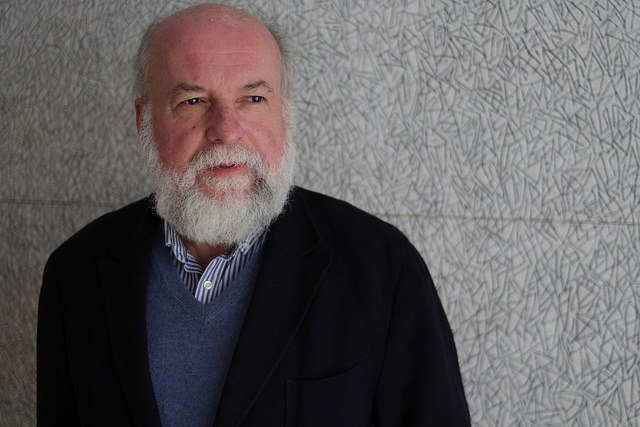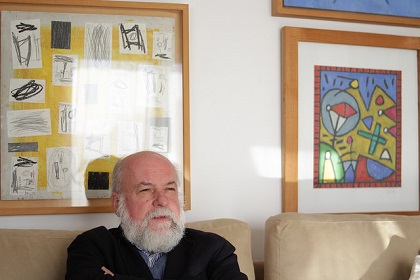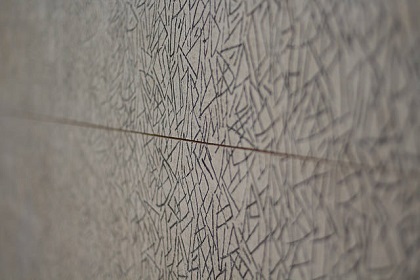Catalan painter Sergi Barnils reflects on the capacity of art to express spirituality. His work continues to be among the delights of many Italian art dealers.
 Sergi Barnils, during the interview. / Jonatan Soriano
Sergi Barnils, during the interview. / Jonatan Soriano
He takes out his glasses from their case and puts them around his neck, where they will remain for the duration of the interview. Sergi Barnils (Bata, 1954) likes to talk about art.
Sitting behind a cup of coffee while talking with quiet gestures, continually touching his cup and the recorder, Sergi is noticeably committed to his work and passion. He demonstrates this commitment to his profession not only through his sensitive dialectic but also the green paint under his nails giving him away.
Among other things, Sergi is a Christian by conversion and abstract by evolution. Although he has organised some expositions in Catalonia (Spain), where he is from and currently resides, his pictorial work is highly prized among some of the main art dealers in Italy and each year they organise between two or three shows in the country of artistic tradition. “They have a lot of feeling for art”, he says.
Despite how his art talks about the strength and the vitality of God, it is found to be “orphaned” within the church. Due to this, his cry is concentrated not in his artistic recognition but in spiritual experience through working with his hands, which is in his case, is inspired. “It is very significant for me that Jesus wanted to be born into an artisan family and there is no doubt that in Joseph’s workshop things were made well”, he expresses.
 Photo: Jonatán Soriano
Photo: Jonatán SorianoQuestion. Let us start at the beginning. Why painting?
Answer. All of this comes from the capabilities that we receive. What happens is that afterwards you have to work hard. But I think that God gives talent for art and that they begin to appear from a young age. In my case it was like that.
When I was little, in school they gave me a national art prize in the year 1964. This was an early sign. The teachers in my school noticed me and they encouraged me. There are no coincidences; this is all linked together. There was an art department run by Francesc Casademont and it was my favourite subject. Therefore, from a young age, I was soaked in talent and discipline. I began to study Law and studied it for two and a half years. My father, a business man, wanted me to be a lawyer and saw that his eldest son had to follow his steps. But I didn’t resist because art calls. When I was with books on Civil Law and Criminal Law and I smelt the smell of turpentine or white spirit, I was stirred inside. From then on it was always a process.
At the beginning, when my children were small, I did a lot of ceramic sculptures to earn a living, but it was always combined with painting. I still practice ceramics. I think that it is a fundamental art. It was one of the first things that the human being did; take a bit of mud, mould it, bake it, glaze it, etc.
Q. But, especially paint. How have you evolved in painting?
A. During a period of time, in the first few years of my adolescence, many colours emerged. I would go to the countryside and work like the impressionists, in “plein air” as the French say, showing the enthusiasm of childhood. But then I began to enter into a darker period and my painting was transformed. I only painted in dark colours, sepias, shades, and this lasted some years.
Both the colours as well as the concepts, the configurations that appeared in the painting, denoted the existential loneliness that I suffered. This was resolved soon after my conversion, when I began to feel restoration and regeneration from God. It is not a coincidence that my painting also evolved towards a lighter palette and towards a concept based on sublime subjects on which to talk about, such as the Bible account of creation or the apocalypse. Curiously I am always between Genesis and Revelation. The last series that I made is a mix of these two books which I believe are very closely connected.
The hope and security of salvation give you another vision of things. When I was younger my life was very dark. Grey. I was always bitter, resentful, angry. I was difficult to handle. I think that, in general, those of us who are craftsmen have a lot of emotions. This is not something that is easy as any little thing could affect us. These emotional alternations are very good when you are working because they favour changes in colour and form. To live in a different dimension enriches the work. But to live it is not that practical because everything affects you and makes you angry. That was what my old self was like, he didn’t regenerate, always suffering, something that could be observed in my paintings. I’m not saying that the paintings I did in that period were not interesting, but I prefer the more recent years after my conversion with the joy transmitted in my work. They are works that have another perfume, a different aroma and sound.
Q. In general, is art spiritual?
A. It is a way of communicating with others and I would say that, in the case of visual art, it is very efficient as sometimes you can say more things with a mass of different colours than through writing chapters and chapters in a book.
It produces a spiritual communication with the observer, without him fully realising it. Kandinsky, one of the first to cultivate abstraction, spoke a lot about this. He stressed the umbilical cord that exists between the artist’s soul and the observer’s; a cord by which the lifeblood flows and produces the adventure that is communication. If the artist’s soul, his warehouse, is stocked with good material, the observer will have more possibilities to receive it, if they are sufficiently sensitive. If it is full of dark mysteries and a strange climate, as was mine before coming to know God, it will communicate this to them. Therefore, for me there is a second aspect that is fundamental; that art is a medium to give testimony to people and give glory to God, given that it is He who inspires all of our being. I am very happy when I put on an exhibition and someone says to me that my work transmits joy and peace as this is what I intend.
Sometimes I explain to them that I have a blank canvas on the easel. Then I go upstairs to a window in the studio where I work that looks out over Collserola (Barcelona) and I pray. After this it seems like the ideas flow and that it is God who moves my hand and puts it in my mind and my heart what I have to say. I understand that there are people for whom it may seem like a suggestion and they don’t give it much importance, but I have been able to experience many times how the work flows and is formed when I have said “Lord, you paint”. The Holy Spirit does not only guide us when we are focused on our good works but also when we are in our profession, whatever that may be. And this is beautiful; to know that God is with you during your work as homo faber, that is, the man who does things with his hands and his head, the craftsman.
 Photo: Jonatán Soriano
Photo: Jonatán SorianoQ. Why abstract art?
A. The teachers that I had were Francesc Casademont, a representational painter and who taught me to love nature, and Nolasc Valls (relative of the ex-Prime Minister of France, Manuel Valls) who taught me to be more disciplined. Besides them, and thanks to the opportunities to work in Germany, Austria and Italy, I have travelled a lot and have seen a lot of art that has influenced me.
Firstly are the impressionists, without a doubt. Secondly, the most freest (not geometrical) abstraction with names such as Willem De Kooning, Mark Rothko, Robert Motherwel, Emilio Vedova and others of the same style which I am passionate about. And from here, one who has always encouraged me to paint is Joan Miró. I capture much spirituality in his work and it is not in vain because he was very inspired from Catalan Romanesque.
Q. You say that you paint all that He has put inside you. Therefore, is God abstract?
A. This could be an explanation; one that is not normally considered. I was very happy painting in “plein air”, but there is a natural evolution that leads a lot of us to express ourselves with a language that I would say is more fundamental. I think that through abstraction you can arrive to a more elevated spiritual level. Those who practice representational artwork may not agree. There was an art critic, Camón Aznar, who said that every organic and alive model penetrates with difficulty the conscience of the spectator. Contrary to “the fields afloat with colour”. And this, unlike shapes, are masses of colour that form part of abstraction and enter more easily into the soul than when there is too much expression. This is one theory. I don’t completely know what it is that led me to abstraction. I think that it was God, of course. In fact, the realism has learnt from abstraction to give fluency to all those shapes and dead spaces that there are in landscapes. It is like a bee that goes to a flower and then produces honey. In the same way abstraction also allows the artist to transmit this spirituality more fluently to the observer.
The mistake is in wanting to understand and justify too many things. We should let ourselves be led by our inner adventure that pays less attention to our minds and more to our emotions.
Q. So do you think you are transmitting the same ecstasy that El Greco was able to reach?
A. Yes, although if I was painting in his era I am sure it would not be abstract, despite how in some of his works you can see a hint of abstraction. But I think that he could arrive there in his own way. El Greco was a huge influence on modern painting, especially from Cezanne. It may seem that I am talking to you about abstraction as if it were the panacea but a hyperrealist could also inject their work with the same spirituality as an abstract painting. Personally El Greco excited me, in the same way as does Kaspar David Friedrich, the German realist. I think that his message is absolutely spiritual. He always painted figures shown from the back, representing man as he gives God all his worries. He also painted destroyed houses as a reference to how short-lived is human glory. Through these symbols we can also see his joy. Painters that know God can express this through the style and the technique that they use.
Q. And what about those who don’t know God?
A. We are all his creatures. Whether you accept it or not, in your interior there is the image of God. Therefore, whether the artist is a believer or not, they are a spark of God’s creativity. Many, whether they like it or not, benefit from the blessing of being God’s creation. In this I don’t want to say that an artist who puts their work in God’s hands is superior than one who does not. The history of art shows that it is not like this. But for us what is important is to give glory to God. Even though the perfume of one of these works may only reach one person and encourage them to follow God, that is enough.
 Photo: Jonatán Soriano
Photo: Jonatán SorianoQ. You spoke about the recognition of spirituality in the abstract. Do you think that the Church has the maturity to recognise artwork in general?
A. The other day I met with a pastor and I explained to him that I would like my work to be bought by a Christian art dealer, from here or another country. But in the evangelical world, up until now, art has been put to one side.
There could be many reasons for this. We could understand it from the weightier point of view that Roman Catholicism has of images, especially in relation to the Baroque period and the Counter-Reformation. I think that we are still living this. However, already we are seeing occasions in which art has evolved, as we were talking beforehand in relation to abstraction, and that now will be the moment for evangelicals to understand that art also forms part of God’s plan. We should enjoy its colours and its various forms. The holistic human is not just piety and intellect. You only have to look at the days of creation. All this is a painting, as God puts the different elements, colours, figures. And we are not even talking about the tabernacle! The project that He put Moses in charge of so that Bezalel and Oholiab made all those beautiful items that so regrettably we are not able to see today. God loves art. He is the most excellent artist. He desires it.
Furthermore, I have also seen that in general the perception of Christians doesn’t differ. They value more virtuosity and knowing how to reproduce something with complete exactitude so that the observer doesn’t have to think because it is all ready done. In the evangelical context abstraction is very hard to accept.
However, above all else, they have to understand this is a profession and not a hobby. On occasions I have found myself with brothers and sisters in the Church who try to treat artistic perception as it is were something to be added on, an extra. But art is very important for the Church. If you ask me why I would tell you that words are surplus. We are talking about the experience in which a Christian person finds themselves in front of a piece of art and, at the very least, can give thanks to God. They can praise Him for the capacity of enjoying the cadmium yellow, the ultramarine, the emerald green, the turquoise. This alone is a reason for prayer and praise. A piece of art work is like a window and once you enter inside, despite however little the painter may talk about a Biblical topic (which is not always necessary) perhaps the believer discovers new spiritual stimuli. If a Christian artist translates into colour chapter 21 of Revelation, the golden streets, the tree of life, the crystal waters, I think that whoever contemplates this work would be enriched and have more inspiration with which to give praise to God. The New Jerusalem will be filled with art and gardens and colours and perfumes and flowers. God has prepared there a scene that from here we can only catch a glimpse of.

Las opiniones vertidas por nuestros colaboradores se realizan a nivel personal, pudiendo coincidir o no con la postura de la dirección de Protestante Digital.
Si quieres comentar o